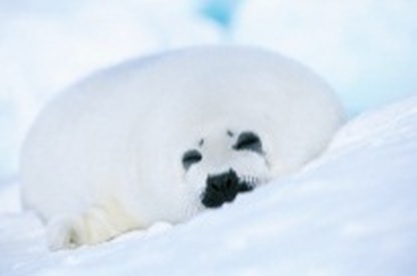Harp Seals Coastal Zone

By: Ansley
“Swish” There is another harp seal swimming through the sea. Harp seals are truly
amazing animals that live in arctic areas. They are mammals, but they prefer water
instead of land. Theirinteresting traits make them really unique animals.
Harp seals have a smooth body and a small flat head. They have a grey body and
pale yellow sides of the body. Harp seals have a narrow snout with whiskers on either
side. Their sixteen teeth are small but very sharp. They have small claws on their front
flippers. Due to these claws the harp seal is able to slide across the ice. An interesting
fact about harp seals is that they have no ears! A male adult harp seal has a
horseshoe shaped marking on its back. That is why they are also considered as
saddleback seals by some people. However, most people refer to the pattern as a
harp. That is how they got their name!
Harp seals are carnivores. Their diet consists of many fish such as polar cod, halibut,
herring, and capelin. They also eat small crabs and shrimp. Their main food source is krill.
Male and females seals return to breeding grounds each year. Some grounds
are located in Newfoundland, The Green Sea, and The White Sea. When all have
arrived the males fight for their mates with sharp teeth and powerful flippers. When
the season is over female seals gather in groups to give birth to adorable baby harp
seals. Baby harp seals are famous for their white fur. These pups are born with no fat so
they are fed on high-fat milk from their mother which will give them blubber. They are kept
on the ice for 6 weeks before they are allowed to hunt on their own. This way they lose up
to half of their body weight and can swim better.
These seals can grow in a range of 5.25 ft. to 6.25 ft. long. The average weight is
400 lbs. They are almost as large as a full grown man. The average life span of a harp
seal is 35 years.
Unfortunately harp seals have a few predators. Harp seals are victims of polar bears,
killer whales, and sharks. They are also threatened by global warming. The fluffy fur of
the babies has attracted hunters for two centuries. This caused environmentalists to be
furious! Luckily hunters have gotten better over the years.
You can find these seals in the North Atlantic and Arctic oceans. You are more likely to
find them diving then on land. They swim faster than they walk. They can also stay underwater
for 15 minutes. So don’t hold your breath.
I hope you enjoyed this presentation. This animal is truly amazing and I hope I inspired
you to do more research on this topic. See you later, the polar bear just realized the baby
harp seal over over there was not a patch of snow.
“Swish” There is another harp seal swimming through the sea. Harp seals are truly
amazing animals that live in arctic areas. They are mammals, but they prefer water
instead of land. Theirinteresting traits make them really unique animals.
Harp seals have a smooth body and a small flat head. They have a grey body and
pale yellow sides of the body. Harp seals have a narrow snout with whiskers on either
side. Their sixteen teeth are small but very sharp. They have small claws on their front
flippers. Due to these claws the harp seal is able to slide across the ice. An interesting
fact about harp seals is that they have no ears! A male adult harp seal has a
horseshoe shaped marking on its back. That is why they are also considered as
saddleback seals by some people. However, most people refer to the pattern as a
harp. That is how they got their name!
Harp seals are carnivores. Their diet consists of many fish such as polar cod, halibut,
herring, and capelin. They also eat small crabs and shrimp. Their main food source is krill.
Male and females seals return to breeding grounds each year. Some grounds
are located in Newfoundland, The Green Sea, and The White Sea. When all have
arrived the males fight for their mates with sharp teeth and powerful flippers. When
the season is over female seals gather in groups to give birth to adorable baby harp
seals. Baby harp seals are famous for their white fur. These pups are born with no fat so
they are fed on high-fat milk from their mother which will give them blubber. They are kept
on the ice for 6 weeks before they are allowed to hunt on their own. This way they lose up
to half of their body weight and can swim better.
These seals can grow in a range of 5.25 ft. to 6.25 ft. long. The average weight is
400 lbs. They are almost as large as a full grown man. The average life span of a harp
seal is 35 years.
Unfortunately harp seals have a few predators. Harp seals are victims of polar bears,
killer whales, and sharks. They are also threatened by global warming. The fluffy fur of
the babies has attracted hunters for two centuries. This caused environmentalists to be
furious! Luckily hunters have gotten better over the years.
You can find these seals in the North Atlantic and Arctic oceans. You are more likely to
find them diving then on land. They swim faster than they walk. They can also stay underwater
for 15 minutes. So don’t hold your breath.
I hope you enjoyed this presentation. This animal is truly amazing and I hope I inspired
you to do more research on this topic. See you later, the polar bear just realized the baby
harp seal over over there was not a patch of snow.
